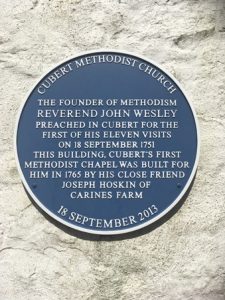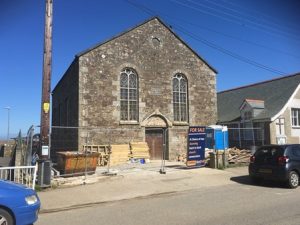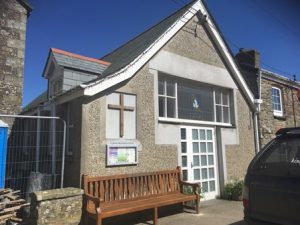
Cubert is a village three miles (5 km) south-southwest of Newquay in the civil parish of Cubert. Once known as St Cubert, the village is dominated by the spire of its 14th-century church which was enlarged by the addition of a south aisle a century later. This profile of Cubert Wesleyan Chapel has been compiled by Jo Lewis and Tony Mansell.
1751: John Wesley first preached here, the first of 11 occasions. He described the village as a” very special resting place”. (Jo Lewis)
1765: Small preaching house built on the corner of Holywell Road and Wesley Street. (See plaque)
John Wesley’s journals record that Mr Hosken added a wing to his house for the preacher’s use, consisting of a parlour and bedroom and known as the Prophet’s Chamber. (Jo Lewis)
 The first Cubert Wesleyan Chapel (Photo: Jo Lewis)
The first Cubert Wesleyan Chapel (Photo: Jo Lewis)
Probably the earliest purpose-built Wesleyan chapel in Cornwall, last used as a restaurant. Built by Joseph Hosken of Carines, in 1765 and whose monument survives in the parish church. Stone and cob construction, originally with a thatched roof. Small porch at the front end. Good vernacular example. Listed with photograph and plan in Stell (b1). (Cornwall Council Heritage Gateway)
By 1907 in use as a Sunday school. (Cornwall Council Heritage Gateway)
 (Photo: Jo Lewis)
(Photo: Jo Lewis)
When the congregation could no longer fit into this little chapel, a second one was built, and the 1765 chapel became a dwelling. (Jo Lewis)
Circa 1848: Cubert Wesleyan Chapel built. (SWChurches)
1894: Attached Sunday school built. (Historic England)
Lean-to organ loft subsequently added to the NE corner. (Historic England)
Porch added to the front (Historic England)
1893: Tenders Invited for Seating and Renovation of Wesleyan Chapel, Cubert, and the Erection and Completion of New Schoolroom. (Cornubian and Redruth Times – Friday 02 June 1893)
1894: Sunday school added to the east side of the chapel, with an internal door leading from the chapel to the school. (Historic England)
1894: “Cubert Chapel Renovation and New School-room. ln connection with the above a stone and brick laying ceremony took place on Tuesday, April 17th. The first stone was laid by Miss Mitchell, on which she placed £10. She being one of the first teachers in the school when it was established was presented with a silver trowel. The second stone was laid by Mr. John Mitchell on behalf of the school children, on which was placed £10. Mr. Mitchell is a brother to Miss Mitchell and was the treasurer of the school at the commencement. The third stone was laid by Miss Janie Rowe Lanyon, … Newlyn East, on which she placed 3 guineas. The first brick was laid by the treasurer of the Band of Hope. Bricks were also laid by Master Wilfred Stephens, Miss M. Stephens, Mr. W. Phillips, snr., Miss Lanyon and F. Stephens. The Rev. W. L. Beadon laid a brick for £4 pounds on behalf of the friends at Crantock…” (Royal Cornwall Gazette – Thursday 26 April 1894)
The Wesleyan Sunday School band of Cubert in 1908. The Methodist chapel had opened 60 years earlier due to an increasing congregation size in the local area. The Sunday School was later added in 1894. Music has always been an important pastime to clay country folk. (Wheal Martyn)
1930s: Sunday school extended to the south bringing it level with the street. (Historic England)
1932: The Wesleyan, Primitive Methodist and the United Methodist Church amalgamated to become the Methodist Church of Great Britain.
1932: Became Cubert Methodist Church.
Article about John Wesley’s visits to Cubert. (Cornish Guardian – Thursday 19 May 1938)
1894-1943: Trust minutes, Cubert Methodist Church. Formerly Cubert Wesleyan Chapel. Minutes of trustee’s minutes including annual meetings. Minutes of meetings 1932-1943 interspersed with those for 1894-1932. (Kresen Kernow MRN/944)
 Cubert Methodist Chapel (Photo: Jo Lewis)
Cubert Methodist Chapel (Photo: Jo Lewis)
The chapel is a three-bay, single-storey building with a gable roof. At the centre of the front elevation is a gabled wooden porch on granite piers, topped by a slate roof with crested ridge tiles (in 2016 the porch roof was temporarily removed). The main entrance is a C20 double door. Above is a blind round granite arch. Above the entrance is a date stone with an inscription in raised upper case lettering reading ‘WESLEYAN CHAPEL AD 1848’ and in the apex of the gable is a recessed circular stone. The entrance is flanked on either side by a two-light C19 margin-glazed casement with top lights and a rounded granite arch with keystone. At the rear there are two blocked openings with granite lintels and keystones. The W elevation has three C19 two-light margin-glazed casements with top lights and flat granite arches with keystones openings, and the E elevation has two. INTERIOR: the chapel retains a rostrum at the N end and a timber gallery at the S end. The gallery is supported by cast-iron columns; it has been suggested these columns are replacements and the base of a timber column stands adjacent to the W end column. Above the auditorium is a sealed timber-plank ceiling. The roof structure is a king-post frame. (Historic England)
The congregation had reduced in size.
2010: Permission granted to remove the organ and the organ loft and to convert the Sunday school into a place of worship. (Historic England)
2011: Cubert Methodist Church closed. (Historic England)
2012: The adjacent Sunday school opened as the new Cubert Methodist Chapel.
 Cubert Methodist Chapel (Photo: Jo Lewis)
Cubert Methodist Chapel (Photo: Jo Lewis)
Pursuant to s.1 (5A) of the Planning (Listed Buildings and Conservation Areas) Act 1990 (‘the Act’) it is declared that the adjacent former Sunday school is not of special architectural or historic interest. (Historic England)
2014: Roof re-slated.
2016: Planning permission granted to convert the former chapel to domestic use. (Historic England)
Architectural interest: the chapel displays architectural detailing which is characteristic of a non-conformist chapel, including rounded window openings and date stone, clearly illustrating its original ecclesiastical use. Historic interest: a good example of a mid-C19 chapel which helps to contribute to our understanding of the development of the Wesleyan Methodist Church in Cornwall. (Historic England)
Sundry documents relating to Cubert Methodist (Wesleyan) Chapel can be found at Kresen Kernow. https://kresenkernow.org/SOAP/search/cubert%20chapel/
